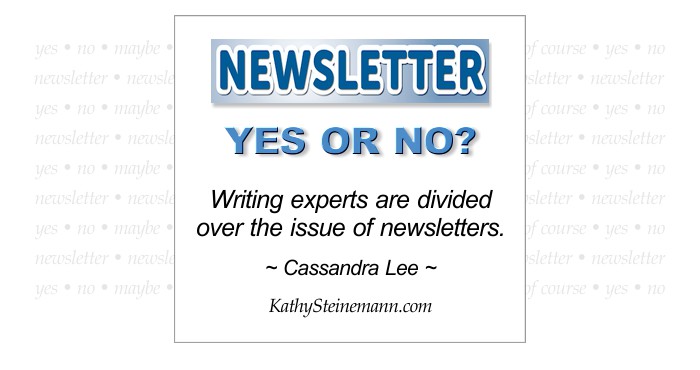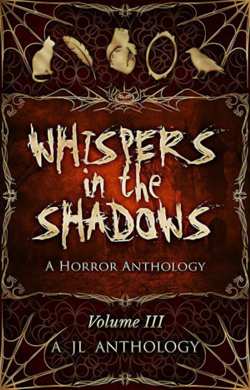
One of the most contentious issues for writers is whether they should publish a newsletter. In this guest post, Cassandra Lee explains her approach.
—
Writing experts are divided over the issue of newsletters: Jeff Goins says yes and Anne R. Allen says no. Here, I’d like to shed light on how the production of my email newsletter and my creative writing endeavors have influenced each other. This guest post will help you decide whether and how newsletters fit into your writing journey and life purpose.
More often than not, writing advice comes from a place of strength, such as from New York Times bestselling authors and publishing industry insiders. Do any of the following sound familiar?
- “Create an outline.”
- “Stick to a schedule and write [this many] words a day.”
- “Show, don’t tell.”
- “Cut out adverbs.”
When beginning writers scour and discover such exquisite word-gems on the internet, they try to apply them rigidly to their early drafts. This results in two unfortunate consequences:

Firstly, just as we place gems outside our body — on our jewelry or apparel — and don’t consume them, editing tips disguised as writing advice are good for external (revision) and not internal (ideation) use. More often than we want to admit, they stymie creativity, rob us of the joy of storytelling, and discourage us from completing our stories. Hence these poor writers end up with the dreaded writer’s block, and their muses go AWOL, perhaps even up to seven years on end.
Secondly, unexpected life events throw a wrench into our writing routines and make it difficult for us to persevere with our magna opera. Recently on the Twitterverse, another writer bemoaned that the two jobs she juggled were draining her of the time and energy she needed to complete her book, and all I could do was encourage her not to give up.
It’s pathetic that perfectionism hampers our storytelling, and that we subconsciously find excuses to push aside our calling to write. I took it upon myself to right both wrongs, and the golden opportunity arrived: NaNoWriMo.
To take advantage of the humongous traffic to my guest post on NaNoWriMo’s blog, I started my newsletter. Counteracting the air of superiority flaunted by the pundits, I began from a place of weakness; I aimed to identify with the humdrum day-to-day struggles of writing, of living, and of the human condition. As the saying goes, “People don’t care how much you know until they know how much you care.” Regarding how best to live the creative life, I don’t have all the answers, but I sure have many questions, and well-told stories, be they in the form of novels, newsletters, podcasts, or drama, inadvertently raise deep, soul-searching questions.
My newsletter is fortnightly, and, if I expect a busy week ahead, I prepare my newsletter in advance. Interestingly, what happens in two weeks’ time provides me with enough fodder for subsequent issues. I may stumble upon interesting happenings, read a special book, listen to an extraordinary podcast, or reflect on my past and ply my memories into coherent narratives. Instead of rehashing lame platitudes such as “If they can do it, you can too,” I illustrate my points through personal stories, which, sometimes, can be downright harrowing, such as the day I ran away from home. In the 48 hours following a domestic altercation, I tried to sleep in unfamiliar territory, returned home groggy, and typed up a piece of flash fiction based loosely on my experience. To my surprise, it got published soon after. Since my other stories and poetry submitted earlier this year were rejected, I still find my first acceptance surreal.
The Writer’s Lexicon series
and additional resources on my Facebook page.
Having to post something every two weeks motivated me to seize every opportunity to write, but pushing myself too hard backfired. In March 2019, I fell ill and lost touch with the muse. Instead of taking a break and risking being forgotten by my subscribers, I gave suggestions on how other writers coped with their ailments. Some famous writers have had a more challenging time than I did, and I’m mindful that rest is just as important to writers as our creative offerings. (I’d like to add that it was Carlos Santana who deemed every practice session an “offering.” Learning across disciplines allows us to think and write in new ways.)
Yet I’d thought of quitting the newsletter altogether — twice. The first time it happened, I didn’t want to talk about the runaway story I mentioned above, and the second time, it was almost midnight, my eyelids were drooping, and the only thing I had in mind was superfluous research I’d conducted for my work-in-progress — it ended up as the sequel, a subscriber-only perk, to my published horror story. Yes, I wrote that short story off the top of my head and finished it in four hours, and I hope my tribe doesn’t mind me goofing off once in a while.
Other times, I’ve had the excellent fortune to discuss key topics in depth, and this is where my newsletter, in turn, impacts my writing. The most enjoyable topic I’ve embarked on so far was discussing obstacles in fiction and in real life, their interplay, and how they inform each other.
Conflicts arise when intentions meet obstacles. In finding inspiration, outlining novels, and completing manuscripts, almost every writer asserts that stories are about conflict, but they rarely provide guidelines on identifying real-life conflicts — not to mention dissecting conflicts, or explaining whether and why they work. This is because conflicts happen in context. The details of fantasy-based conflicts differ from those characterizing historical fiction or romance. It’s easy to list and bash tropes and genre conventions, but we’re wary of elaborating on how to subvert them cleverly, lest others steal our brilliant ideas too soon.
Thanks to my STEM (science, technology, engineering, mathematics) education, I’m now much more mindful than my juvenile self of possibilities and limitations in the physical world. In his MasterClass, R. L. Stine avoids smartphones in his fiction, believing that mobile applications such as Google Maps trivialize journeys that, had the wrong turn been taken, could have become epic adventures. Nevertheless, my horror story delves into the dark side of cybersecurity and includes smartphones. Perhaps — this is pure speculation on my part — perhaps when R. L. Stine pictured a smartphone, he saw all the utopian possibilities presented by optimistic technologists, but he could only conjure up horror plots that our smart devices render unlikely or absurd, such as getting lost in the woods for an inordinately long time, when the characters could have navigated using GPS. Yet, when I think of smartphones, I consider phone users with their heads low, their shoulders hunched, their eyes glued to the screen, and their chief concern being battery life. Their godlike gadgets then lead them to (warning: please skip ahead to the next paragraph if you fear disturbing content) drive off cliffs …
I trace my newfound interest in obstacles to my childhood love of speculative fiction, especially fantasy. Back then, I’d thought magic could solve any problem, time-travel could amend all faults, and, well, anything was possible. As a little girl, I wanted to learn how to cast elemental spells that would afflict my enemies and stop them from mistreating me. If I did poorly in an exam, I was obsessed over how to travel back in time and correct my paper. I couldn’t understand why many fictional characters were so dumb as to court trouble willingly throughout their novels, and why they didn’t see that my supernatural solutions could have spared them their book-length agony.
With age comes disillusionment — miracles don’t always happen, plus I’ve chosen faith over magic — and, thankfully, discernment. Physical laws govern the world, communities enforce unspoken rules, and people have limiting beliefs and constraints that hinder them from optimizing their positive influence in the world. For example, many entrepreneurs emulate the late Steve Jobs, regarding his mean, loveless traits as his keys to success. However, love also leads to success. Who is correct? There’s no easy answer, but sometimes it’s in the quest to answer our questions that we discover ourselves and what we stand for. Methinks Steve Jobs might not have been the ideal role model for youths, but his Stanford commencement speech was inspiring.
I’ve yet to showcase merchandise on my mailing list, and I know I’m going against the mainstream marketing advice that screams the “convert leads into sales” refrain, which means we must turn email subscribers into paying customers. As much as I’m tempted to pad my bottom line, I can’t agree with the mantra in quotes, because I’ve only just started my writing journey. I have little to sell but much to provide gratis.
Freebies: I have a love-hate relationship with them. They lured me into signing up for hundreds of newsletters. Many of them guilt-tripped me into impulse purchases; bad purchase after bad purchase made me rethink my expenditures online, so I unsubscribed from those emails. Those that I remain subscribed to have earned my loyalty by consistently offering bonus content without cost, and I gather that, by being vulnerable, generous with my resources, and nowhere near anxious over my profits, I can better encourage others who share my passion for writing than those greedy of gain.
© Cassandra Lee
—
Despite the intense pressure of living in Hong Kong, Cassandra Lee writes to inspire. A lover of stories, she excavates them from real-world data by day, and from her imagination by night. Her publications include an essay on female mathematician Emmy Noether and a cybersecurity horror story, and she has blogged for Huffington Post and National Novel Writing Month.
—
Do you agree that writers should publish newsletters? Why or why not?
The Writer’s Lexicon series
and additional resources on my Facebook page.
Discover more from KathySteinemann.com: Free Resources for Writers
Subscribe to get the latest posts sent to your email.


Cassandra–You’ve written a heartfelt, thoughtful piece here. And you’ve shown how a weekly or bi-weekly writing routine has helped you grow as an author.
I’d like to point out that all these things you’ve sent out as a newsletter could also be put into a blog. And a blog has the advantage over a newsletter in being open to new readers, who might stumble on your pieces and share them, and bring you new readers.
A newsletter is a closed ecosystem, while a blog is open and growing. People can interact with a blog community in the comments section, while they can’t with a newsletter. Those are the only real differences between the two mediums.
But a newsletter audience is more private. And if you’re writing personal, private stuff (or things that are NSFW) and you don’t want your work to be read by the general public, then a newsletter is the better choice.
Thanks for your insightful comment, Anne. Akismet routed it you-know-where, but I rescued it.
Hello Anne, thanks for your comment. Every author should be fully convinced of their reasons to have or not to have a newsletter.